Improving ER Communication!
Help Your Nurses Stay Ahead of Patient Arrivals
Optimize patient flow and eliminate manual calls with Qanty.
Emergency rooms are incredibly demanding. Every minute counts, but many ERs still rely on calls or radios to notify nurses of a patient’s arrival. That’s where Qanty, an intelligent Queue Management System (QMS), comes in. We connect the front desk to the triage and treatment staff in real time, ensuring nurses are instantly informed to improve response times and efficiency.
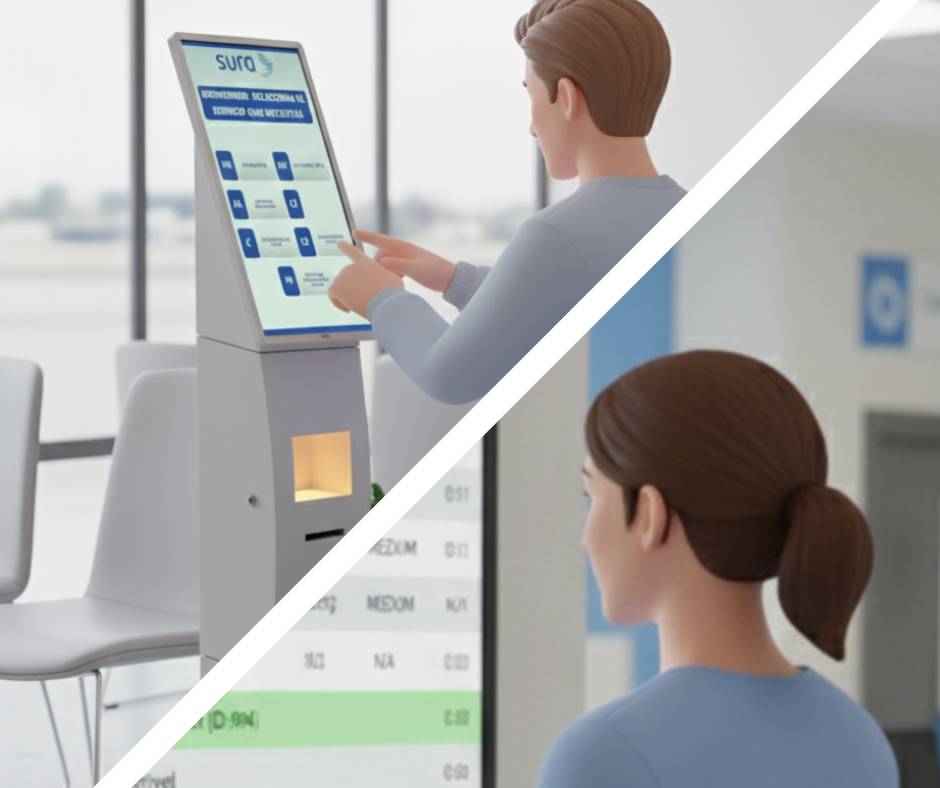
When a patient checks in at the ER front desk or kiosk, Qanty automatically updates a centralized dashboard accessible to all staff. Nurses in triage or treatment areas can see:
This eliminates the need for manual calls or repeated updates, giving nurses instant awareness of who’s waiting and how long they’ve been there.
With live updates, the triage team can act faster. Qanty’s system allows hospitals to define priority tags or alerts. If a patient reports chest pain or another critical symptom during check-in, the system automatically flags it to nurses.
This proactive alerting helps ensure that no critical case goes unnoticed, even during high-traffic hours.
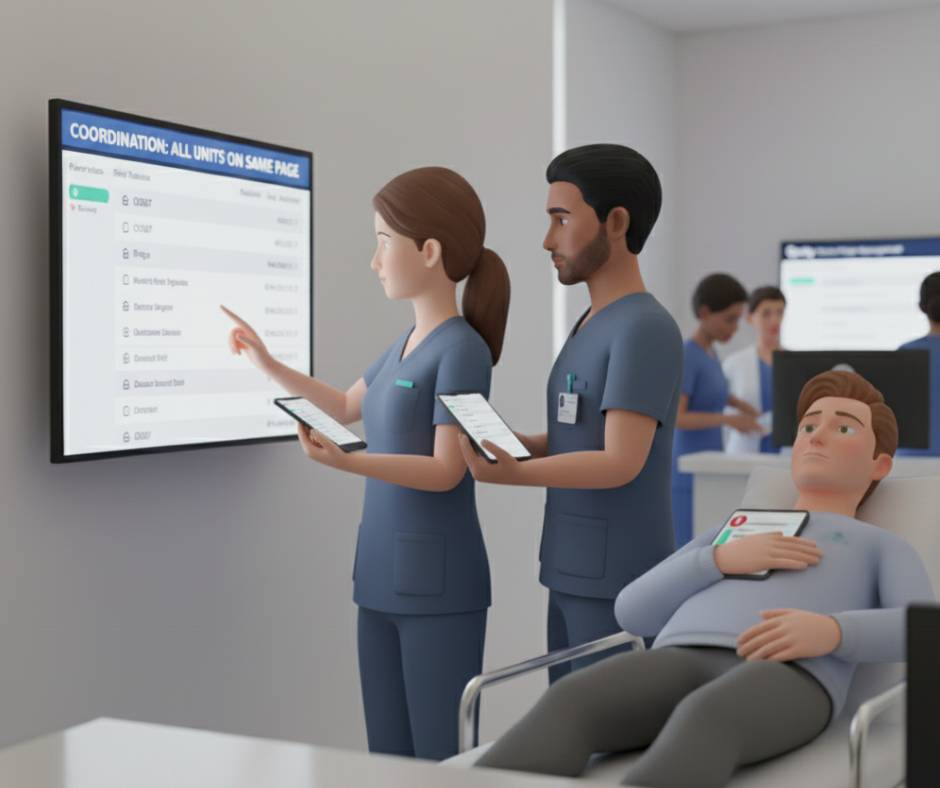
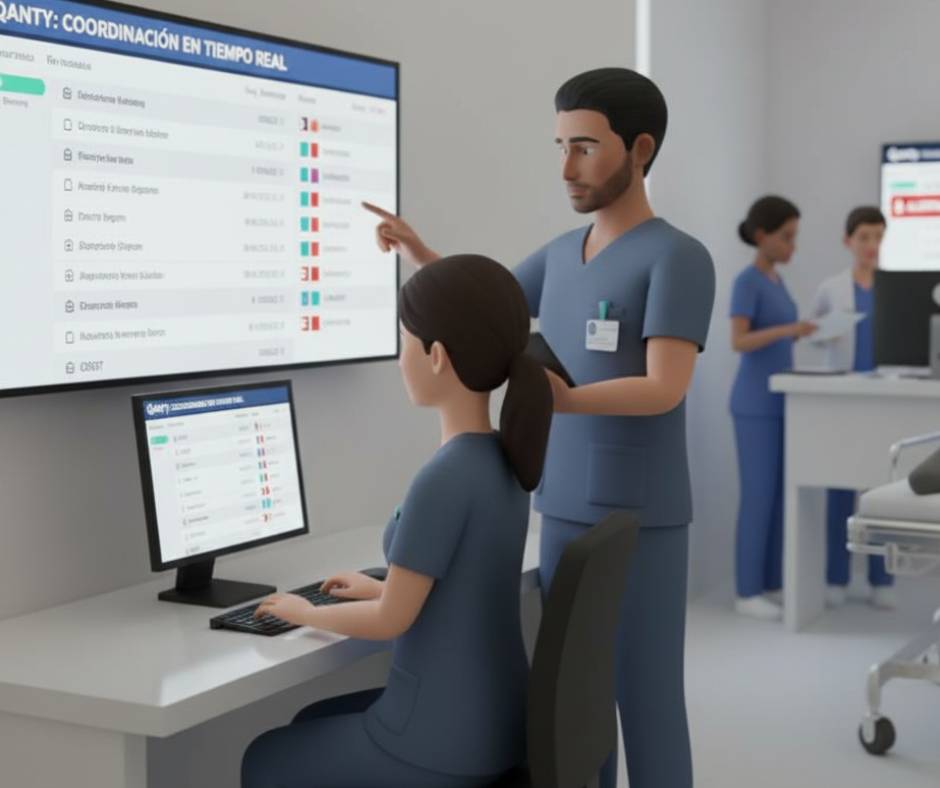
In busy ERs, communication breakdowns are common. Qanty bridges this gap by enabling seamless coordination between departments. Everyone—from registration staff to triage nurses—works off the same data in real time.
Notifications can also be configured to appear on monitors, tablets, or mobile devices, ensuring that the right person sees the update immediately, no matter where they are in the unit.
Long waiting times are one of the main sources of frustration in ERs. With Qanty, hospitals can display estimated waiting times or status updates on patient-facing screens, improving transparency and reducing anxiety.
When patients feel the process is organized and that staff are aware of their arrival, overall satisfaction increases significantly.
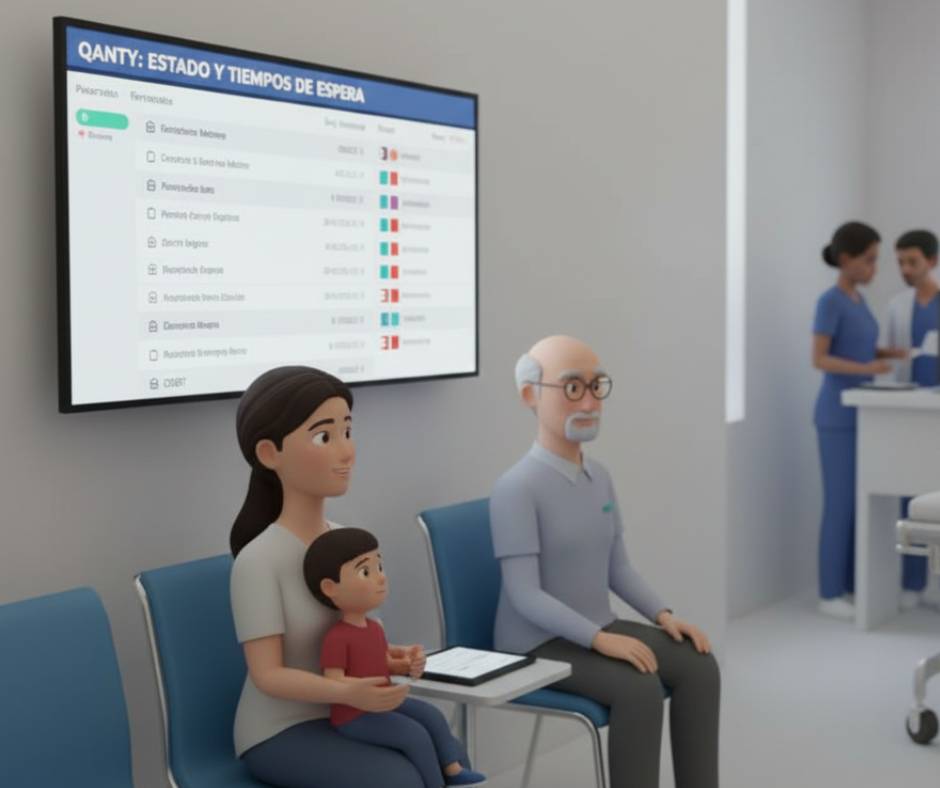
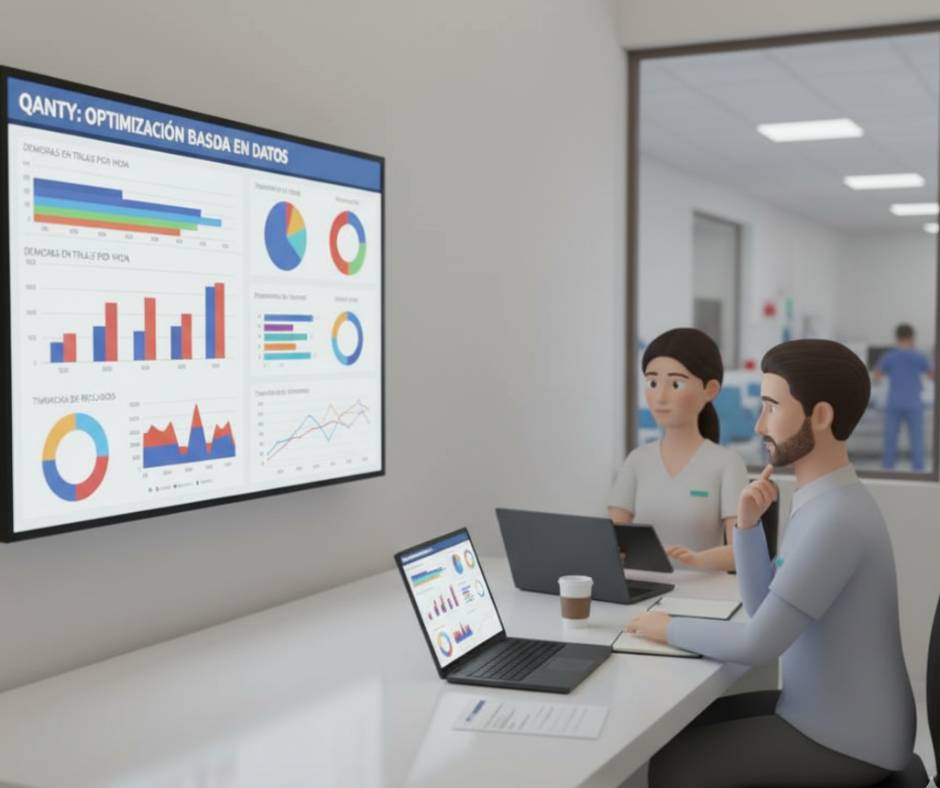
Every check-in, wait time, and service duration is recorded in Qanty’s analytics system. This provides valuable insights for hospital administrators to identify bottlenecks, measure staff response times, and optimize resource allocation.
For instance, data might reveal that certain hours of the day consistently have longer triage delays — helping managers adjust staffing accordingly.
Qanty can integrate with existing hospital systems (EHRs, patient management tools, or internal alert systems), reducing the learning curve for staff.
Its modular design allows ERs to start with basic check-in and alert functions and later expand to include full workflow automation, kiosks, or patient communication tools.
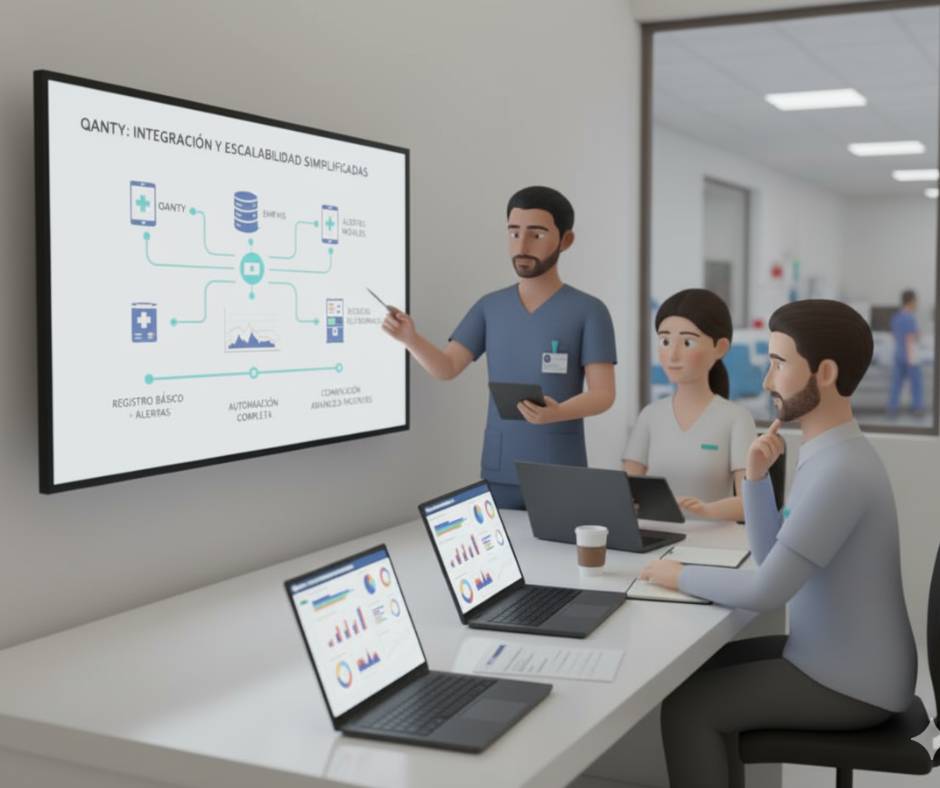
Did you know?
In busy emergency rooms, communication breakdowns are a leading cause of treatment delays and patient dissatisfaction. A real-time notification system closes this gap, instantly connecting the front desk with the triage team.
Qanty uses a centralized dashboard that updates in real time. These notifications can be displayed on large monitors in nursing stations, as well as on staff tablets or mobile devices, ensuring they see the alert no matter where they are.
The system allows hospitals to configure “priority tags” or automatic alerts. If a patient checks in with critical symptoms (like chest pain), the system automatically flags them with high priority on the dashboard, ensuring the triage team identifies them immediately.
No. Qanty is designed to integrate with your existing systems, including EHRs and other patient management tools. It acts as a communication and workflow bridge that enhances the systems you already use, without replacing them.
Qanty records every step of the process. You can analyze key metrics like total wait times, triage duration, staff response times by hour, peak traffic, and bottlenecks. This allows administrators to make data-driven decisions to optimize staffing and workflows.
Discover how Qanty’s management system can eliminate communication gaps, reduce wait times, and empower your nursing team to focus on delivering quality care.
Queue management systems are transforming various sectors such as healthcare, banking, retail, entertainment, and transportation by improving customer experience and optimizing operational efficiency. These systems help manage the flow of people more effectively, reduce wait times, and provide real-time updates. Their implementation enables faster and more efficient customer service, providing a significant competitive advantage for businesses that adopt them.
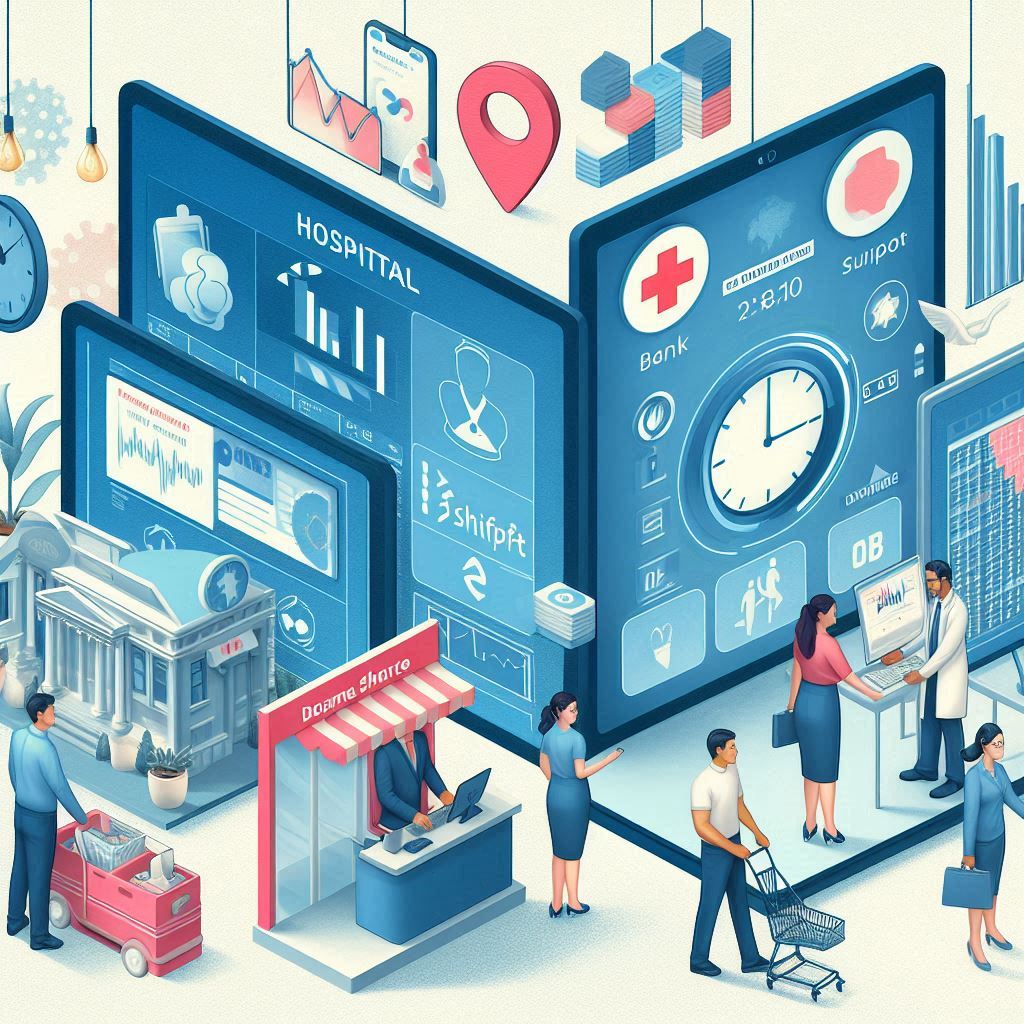
Queue management systems are revolutionizing how organizations optimize their operations and enhance the customer experience. These systems efficiently manage the flow of people in key sectors such as healthcare, banking, retail, entertainment, and transportation. By reducing wait times and streamlining interactions, businesses not only increase productivity but also gain a competitive edge in an increasingly demanding environment.
In healthcare, these systems are essential for improving patient care. In hospitals and clinics, prioritizing cases based on severity helps reduce wait times in critical areas such as emergency rooms and consultations. Additionally, these tools provide real-time tracking of waits, offering instant updates to patients and enhancing their customer experience. Operational efficiency is also increased by reducing congestion in service areas, thus optimizing the use of medical resources.
In the banking sector, operational efficiency is crucial, and queue management tools offer a practical solution for organizing customer flows. These technologies enable dynamic resource allocation, prioritizing tasks based on demand, which reduces the workload at branches. By implementing these solutions, banks improve customer experience with features like virtual appointment scheduling, minimizing the need for in-person visits. Shorter wait times increase satisfaction and customer loyalty.
The public sector, with its high volume of users, also benefits greatly from these systems. Government offices implement virtual tickets that allow citizens to know their estimated wait time and receive notifications on the status of their services. This organization not only enhances the customer experience but also increases operational efficiency by preventing overcrowding and reducing unnecessary travel. The use of digital tools optimizes human resources and speeds up bureaucratic processes, contributing to the digital transformation of public services.
In retail, these systems are essential for enhancing customer experience in physical stores and shopping malls. They organize lines, making it easier to allocate staff according to customer demand, especially during peak times. Additionally, they use analytics to predict customer flows and organize queues more efficiently, minimizing wait times. This directly impacts the customer experience, as quicker service leads to higher satisfaction and customer retention, driving the digital transformation of retail operations.
The entertainment sector, including cinemas and theme parks, has also found these systems to be a valuable tool for organizing access to events and attractions. They manage ticket sales, entry points, and queues to ensure a smooth experience for visitors. By reducing congestion, they enhance the customer experience and optimize the flow of people, allowing companies to offer quality service, benefiting from operational efficiency.
In sectors like transportation, where punctuality is crucial, queue management tools play a vital role. Airports and train stations use these systems to manage check-ins, security checks, and boarding, reducing the risk of overcrowding and ensuring that passengers can complete their processes more quickly and efficiently. This improves both the customer experience and operational efficiency in the sector, contributing to the overall digital transformation of transportation.
Queue management systems are key to optimizing customer experience and maximizing operational efficiency, driving business competitiveness.
Ready to take your service to the next level and improve your business’s operational efficiency?
With our queue management systems, you’ll optimize your customers’ experience and reduce wait times. Contact us today and let us show you how our solution can transform your operations. We are here to help you take that important step into the future!
Efficient queue management transportation solutions are essential for optimizing passenger flows. By utilizing advanced transportation automation systems and terminal technology solutions, these systems improve passenger organization, streamline processes, and enhance mobility optimization. This approach not only reduces waiting times but also increases transportation operational efficiency, ensuring a seamless and sustainable transit experience.
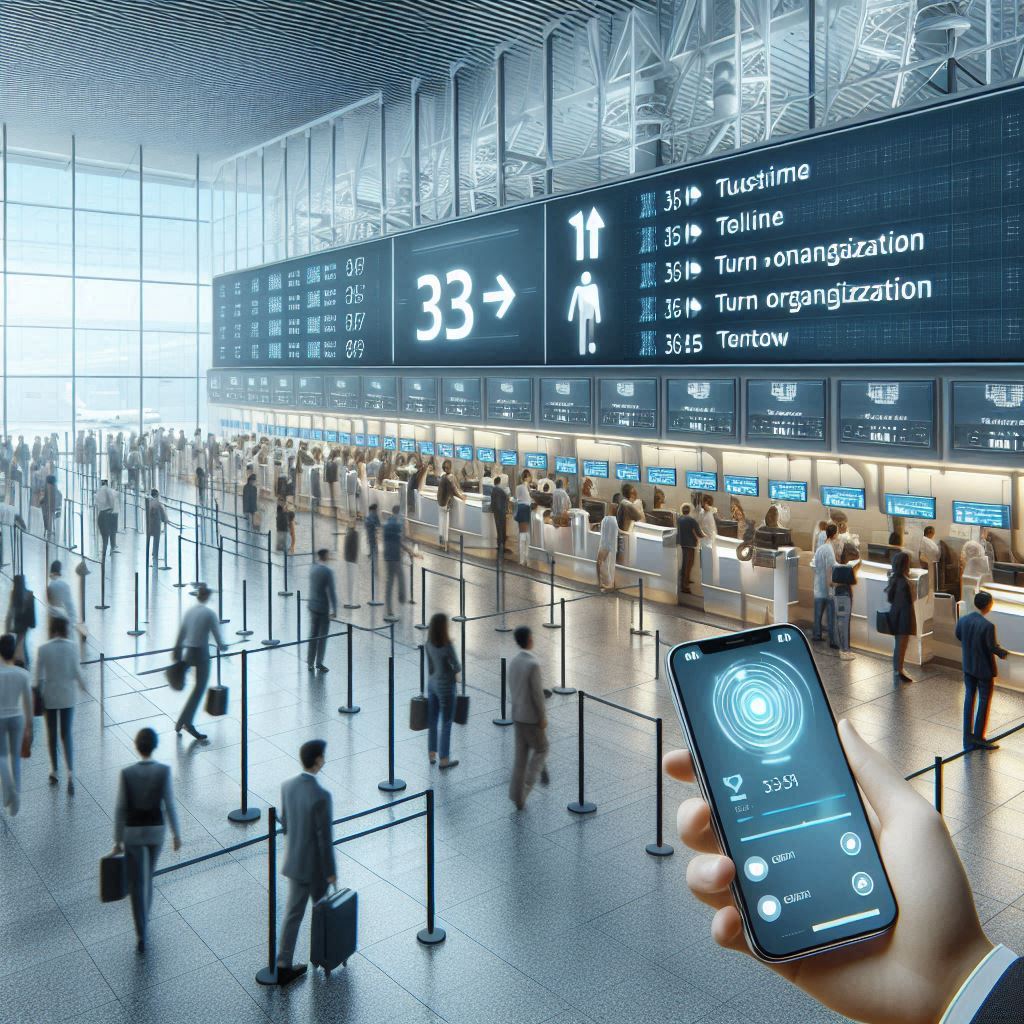
In the transportation sector, efficiently organizing passenger flows is crucial for ensuring smooth and safe operations. Queue management systems have become essential tools, especially at bus terminals, train stations, and airports. These solutions not only optimize the flow of people but also contribute to improving the user experience and operational efficiency in high-traffic environments.
At transportation terminals, these systems assign turns and organize queues through the use of advanced technologies, such as interactive kiosks, informational screens, and mobile apps. These tools allow passengers to access real-time information about schedules, boarding locations, and estimated wait times. This not only reduces uncertainty but also streamlines processes, eliminating disorder and unorganized queues.
For example, at an airport, digital screens and mobile apps keep travelers informed about the status of their flights, the assigned boarding gate, and the remaining time before boarding. This level of detail enables passengers to manage their time efficiently, avoiding unnecessary congestion in critical areas such as security checkpoints or waiting rooms.
One of the most valuable features of transportation queue management solutions is their ability to adapt in real-time to fluctuating demand. During peak seasons, such as holidays or special events, these systems automatically adjust queue assignments and resource allocation. For example, at a train station, additional service points can be activated to manage large passenger crowds, maintaining order and reducing congestion.
Moreover, these systems collect and analyze data on usage patterns, enabling transportation companies to anticipate demand spikes and strategically allocate staff and resources. This forecasting capability improves not only operational efficiency but also customer satisfaction by minimizing wait times and frustrations.
In addition to enhancing organization, implementing these systems also boosts safety. By pre-assigning queues, the risk of accidents in crowded areas is minimized, ensuring a controlled flow of passengers even during peak hours. Furthermore, reducing wait times and promoting the use of digital platforms helps minimize energy consumption and decreases the need for physical resources like paper, supporting sustainable practices.
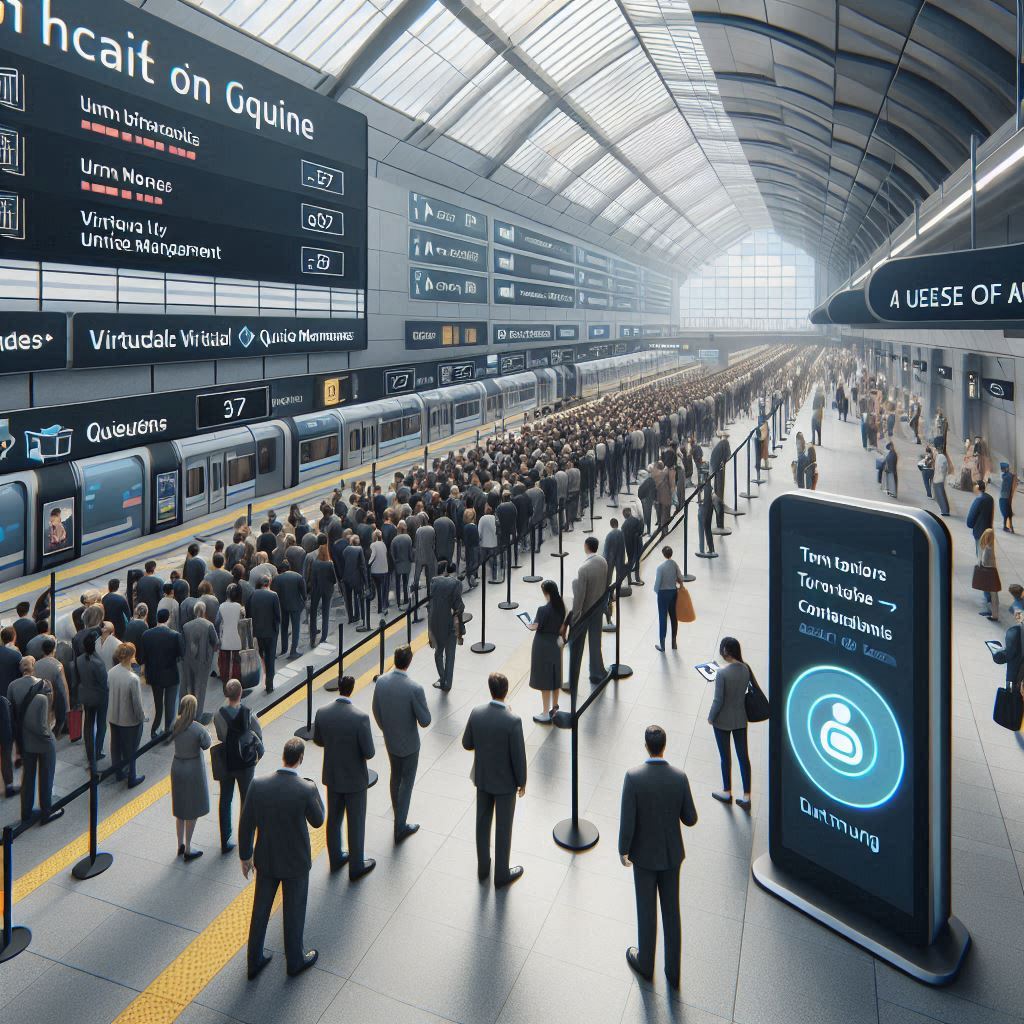
Queue management systems in transportation modernize services, optimize the user experience, and promote sustainability and innovation.
Want to transform your passengers’ experience and optimize your operations?
Discover how Qanty’s queue management systems can take your service to the next level. Contact us today and start designing customized solutions for your needs.
Queue management systems in healthcare have transformed patient care by reducing wait times, optimizing resources, and improving the patient experience in clinics and healthcare centers. These solutions integrate technologies like automated scheduling and real-time data, prioritizing urgent cases and efficiently organizing patient flows. Additionally, their implementation allows institutions to adapt their operational capacity based on demand, strengthening the planning of medical resources. These digital tools are key to modernizing the healthcare sector and ensuring faster, more organized care.
Queue management systems reshape patient care dynamics in medical centers by optimizing patient flow and enhancing service quality. Efficient queue management organizes care precisely, prioritizes each patient’s needs, and maximizes the use of available resources. This approach is essential in hospitals and clinics, where every second can mean the difference between successful care and a critical delay.
Queue systems achieve reduced wait times by registering and classifying patients according to the urgency of their conditions. Thanks to automated scheduling in healthcare, critical cases receive priority attention, while less urgent cases are managed in an orderly manner. This process eliminates chaos in waiting rooms, improves the patient experience, and strengthens confidence in the services offered by medical institutions.
The integration of technology in healthcare centers enhances the effectiveness of queue management systems. Digital screens and mobile applications provide patients with real-time updates on their turn and estimated wait times. This access to information is crucial for those facing mobility barriers or needing to plan their visit in advance.
Moreover, digitalization streamlines hospital management by providing data to analyze care patterns and adjust resources as needed. During public health emergencies, such as the COVID-19 pandemic, digital tools managed patient flows securely and orderly, preventing overcrowding and improving responses to critical situations.
Optimizing medical resources plays a fundamental role in the success of these systems. By analyzing real-time data, hospital managers can strategically allocate staff and equipment. During high-demand periods, additional service stations are activated or staff is redistributed to ensure a continuous flow of patients. These measures not only improve service quality but also reduce operational costs.
The use of digital solutions in healthcare enhances sustainability by replacing physical tickets and additional signage with digital tools. This shift reduces environmental impact and improves internal and external communication within healthcare institutions.
Queue management in hospitals not only improves efficiency but also boosts patient satisfaction by ensuring faster and more organized care.
If you’re ready to transform your patients’ experience and optimize care with innovative solutions, don’t hesitate to reach out to Qanty! We’re here to help take your hospital management to the next level.
Queue management systems are transforming the financial sector by driving the optimization of financial resources and enhancing the personalization of banking services. These solutions leverage automation to reduce wait times and improve the customer experience. Additionally, they enhance operational efficiency in banks, adapting to real-time demand and strengthening digital financial transformation.
Queue management in the financial sector has revolutionized how banks and other financial institutions operate. Reducing wait times not only improves the customer experience but also drives operational efficiency. In bank branches, for example, the implementation of digital ticketing eliminates long queues, enabling customers to receive personalized attention in less time. This approach transforms how financial institutions are perceived and fosters customer loyalty.
Systems that optimize financial resources are essential for responding to demand variability. With digital tools, institutions analyze historical and real-time patterns to strategically allocate staff. During peak hours, banks can reinforce customer service teams, while in quieter times, staff can be redistributed to key areas. This model ensures smooth operations, reduces costs, and minimizes the risk of errors in management.
Moreover, enhancing the customer experience in banks strengthens trust in the brand. Queue management systems provide an organized, transparent experience, offering real-time information about estimated wait times. Customers appreciate this predictability, as it allows them to optimize their time and reduces the stress associated with long waits at branches.
Digital transformation in banking has integrated tools like mobile apps and self-service kiosks. These technologies allow customers to book their appointments from anywhere, adapting to their needs. When arriving at a branch, users experience faster and more personalized service, thanks to the data collected beforehand. This strategy not only enhances service but also strengthens the relationship between the institution and the customer by demonstrating a deep understanding of their needs.
During contingencies like the COVID-19 pandemic, digital queue management allowed financial institutions to quickly adapt to health regulations. By limiting the number of people inside the premises and efficiently managing the flow of users, these tools ensured operational continuity in a safe environment.
Innovation in financial services through queue management provides significant competitive advantages. Institutions that implement these solutions stand out in a demanding market where customer satisfaction is crucial. Reducing complaints, increasing efficiency, and offering a seamless experience translate into a better brand reputation and higher customer retention rates.
Queue management in the financial sector reduces costs and enhances the customer experience in real time.
At Qanty, we are ready to help you transform your customers’ experience by optimizing every interaction and improving the efficiency of your operations. With our innovative solutions, you can provide faster and more personalized service. Let’s explore how we can work together to elevate your customer service to the next level!
Queue management in clinical laboratories is essential for enhancing operational efficiency and patient satisfaction. With the integration of digital systems, labs can better allocate resources, adjusting staff levels and service times in real-time to meet demand. These systems minimize waiting times by providing patients with precise information and the ability to manage appointments seamlessly. Resource optimization not only boosts productivity but also reduces operational costs, ensuring higher-quality service and improved patient satisfaction.
Efficient queue management in clinical laboratories significantly impacts patient satisfaction. Turn-based systems allow patients to see accurate wait times, reducing uncertainty and enhancing their overall experience. With real-time updates and appointment management accessible from mobile devices, labs create a seamless experience for their users. Eliminating long queues and unnecessary waiting times decreases stress and fosters trust, strengthening the bond between patients and healthcare providers.
Queue management also streamlines the operational workflows of clinical laboratories. By automating tasks such as turn allocation and patient distribution, these systems reduce human errors and ensure timely and accurate service delivery. This approach helps labs maintain a steady patient flow while avoiding bottlenecks in the care process.
Digital tools provide labs with a clear view of workflow patterns, enabling managers to pinpoint areas for improvement and make real-time adjustments to optimize performance. The data generated by these systems helps laboratories analyze demand patterns, reallocate resources effectively, and maintain top-notch service standards while minimizing patient wait times.
Digital transformation has been pivotal in enhancing patient care and resource utilization in clinical laboratories. By adopting queue management systems, labs optimize resource allocation, improve communication with patients, and deliver a smoother, uninterrupted experience. These advancements not only enable faster and more personalized services but also boost competitiveness in the ever-evolving healthcare industry.
Queue management revolutionizes clinical laboratory operations by optimizing resources, expediting care, and elevating patient experiences.
Ready to Boost Your Lab’s Performance?
At Qanty, we specialize in digital tools that transform queue management, ensuring operational excellence and superior service quality. Let’s work together to drive your lab’s transformation!
Videobanking is transforming financial services by offering remote advisory solutions and virtual banking services. This innovation enhances customer service by combining digital technology with human interaction, enabling customers to access services from anywhere. Videobanking also fosters financial inclusion, allowing more people, even in remote areas, to benefit from banking products. Furthermore, by reducing the need for physical infrastructure, it optimizes operational efficiency in financial institutions, improving productivity and lowering costs.
Videobanking is redefining the interaction between financial institutions and their clients. This technology combines operational efficiency with personalized service. Users access advanced virtual banking services from anywhere, eliminating the need to visit physical branches. The combination of technology and human advisory enables institutions to offer solutions tailored to each client’s specific needs.
Thanks to videobanking in financial services, banks strengthen their competitiveness by integrating digital platforms into their operational strategy. This allows them to reduce costs associated with physical infrastructure and centralize services on virtual channels. Furthermore, videobanking facilitates the collection of valuable data on customer behavior, driving informed decision-making. This tool also promotes financial inclusion, connecting more people to the formal banking system.
A key benefit of videobanking is its ability to overcome geographical barriers. Many communities lack direct access to financial services due to the absence of nearby branches. This digital solution promotes financial inclusion by bringing virtual banking services closer to those who need them the most.
Customers appreciate the ability to resolve complex financial matters with an expert, without long wait times. Additionally, complementary technologies like electronic signatures streamline transactions, further enhancing the overall experience. This elevates customer service standards. Videobanking enables digital customer service, reducing the need for physical visits and improving convenience and speed.
Videobanking not only improves the relationship between banks and clients but also boosts productivity. By reducing the need for physical travel, advisors can assist more people in less time. This scalability strengthens the sustainability of financial institutions in highly competitive markets.
With videobanking, advisors can provide remote financial advisory, helping clients make informed financial decisions from anywhere. This approach also optimizes operational efficiency, as banks can assist multiple clients simultaneously without compromising service quality.
The strategic use of videobanking allows for the integration of solutions such as real-time analytics and service personalization. These tools create a more engaging and efficient experience, ensuring customer loyalty. Virtual banking services enable customers to perform transactions, queries, and consultations from the comfort of their homes.
Videobanking offers accessible remote financial advisory and enhances the operational efficiency of institutions by reducing costs and optimizing digital customer service.
It’s time to take your financial institution to the next level!
With our videobanking solutions, you will enhance digital customer service and facilitate remote financial advisory. Don’t let distance limit your service.
Contact us today and discover how to optimize your operations and improve your clients’ experience.
Smart technology for restaurants in restaurants, such as queue management and wait management systems, enhances the customer experience by reducing frustration during waiting times and increasing operational efficiency. These systems not only optimize workflow but also promote revenue growth by enabling more purchases while customers wait. Additionally, the implementation of technology in restaurants strengthens the brand and positions the establishment as innovative and competitive.

In the restaurant industry, operational efficiency is key to improving the customer experience and increasing revenue. Smart technology like queue management is transforming how restaurants manage customer wait times, which not only improves the dining experience but also optimizes internal workflow. Wait management systems allow customers to receive updates on the status of their table without having to wait in long lines, creating a more relaxed and comfortable atmosphere.
Restaurants are adopting technology for restaurants to make every aspect of the customer experience more efficient. The use of wait management systems, such as automated notifications informing customers when their table is ready or their order is complete, reduces frustration and improves satisfaction. This type of technology not only allows better time management but also fosters customer loyalty by making them feel that their time and comfort are important to the restaurant.
Another benefit of implementing these smart systems is the increase in revenue growth. Customers, having the freedom to explore while they wait, tend to make more purchases, whether in drinks or appetizers. This generates a better customer experience, while also increasing the average spend per customer, directly impacting the restaurant’s revenue growth. Moreover, wait management systems allow for better table turnover and optimized customer distribution, further boosting the restaurant’s operational efficiency.
The benefits are not only tangible for restaurants but also for employees. By reducing congestion in waiting areas, queue management systems allow staff to focus more on other tasks, such as attending to customers at tables. This type of solution optimizes staff workflow, improving the work environment and increasing the overall productivity of the restaurant.
Technology in restaurants also helps to improve the brand experience. Restaurants that implement such innovative systems show their commitment to customer comfort and continuous improvement. This positions the restaurant as a modern and customer-focused establishment, which can be a determining factor in attracting new customers. Additionally, a restaurant that invests in smart technology is better prepared to meet the demands of an increasingly competitive market.
Restaurants that implement smart technology achieve a smoother and more efficient experience for both customers and employees.
At Qanty, we want to support you on your journey towards a more modern and efficient service. Write to us to explore together how our solutions can transform your restaurant, improving the customer experience and optimizing every detail of your operations. We are here to help you take the next big step!
Queue management systems in telecommunications have transformed customer service optimization, enhancing the customer experience and reducing wait times. Thanks to technology, companies streamline customer service, optimize resources, and adjust service based on demand. This solution not only increases operational efficiency but also promotes accessibility and inclusion for all users.

In telecommunications, queue management in physical branches is not just operational but also essential for improving the customer experience and maintaining competitiveness. After all, face-to-face interactions remain crucial for resolving technical issues, subscribing to services, or making adjustments. Moreover, wait times and queue organization directly impact customer satisfaction. Queue management systems effectively optimize these interactions, allowing businesses to manage demand and improve service quality.
One of the most notable features of queue management systems in telecommunications is their ability to adapt to high demand. During key moments, such as new service launches or updates, these systems allow for real-time resource reconfiguration. Consequently, traffic spikes increase customer volume and require adjustments to service points. As a result, this reduces wait times and prevents employee saturation. Ultimately, this improves operability and ensures quality service without chaos.
The systems not only manage the queue but also optimize the entire customer’s interaction with the company. Through tools such as mobile apps and web platforms, telecommunications customers can easily book slots, schedule appointments, or receive real-time notifications about their queue status, estimated wait time, and service point locations. This digitalization not only enhances customer comfort and satisfaction but also reduces crowding in branches. In turn, this contributes to a more controlled and efficient flow of people. This ability to manage demand from outside physical premises reflects a modern telecommunications strategy that aligns with the expectations of an increasingly digitalized user.
Furthermore, one of the greatest benefits of queue management systems in telecommunications is their ability to collect and analyze real-time data. These systems provide valuable metrics, such as wait times, the most frequent requests, and staff performance. By using this data, companies can optimize resource allocation, predict demand, and make real-time adjustments to ensure that customers receive swift attention. In such a competitive environment, where every minute counts and fast service is crucial, this analytical capability allows telecommunications companies to proactively respond to customer needs.
The flexibility of queue management systems also extends to remote support services. Integration with digital platforms enables customers to manage not only physical queues but also online interactions. This, in turn, helps alleviate pressure on branches during high-demand periods. Ultimately, this synergy between the physical and digital creates a smoother and more accessible environment, improving the customer’s perception of the company.

Queue management systems in telecommunications optimize customer service, reduce wait times, and improve operability during peak demand periods.
Take advantage of this technology to improve your service and differentiate yourself in a competitive market.
Discover how Qanty can transform your customers’ experience with customized queue management solutions. Contact us today and optimize your operations.